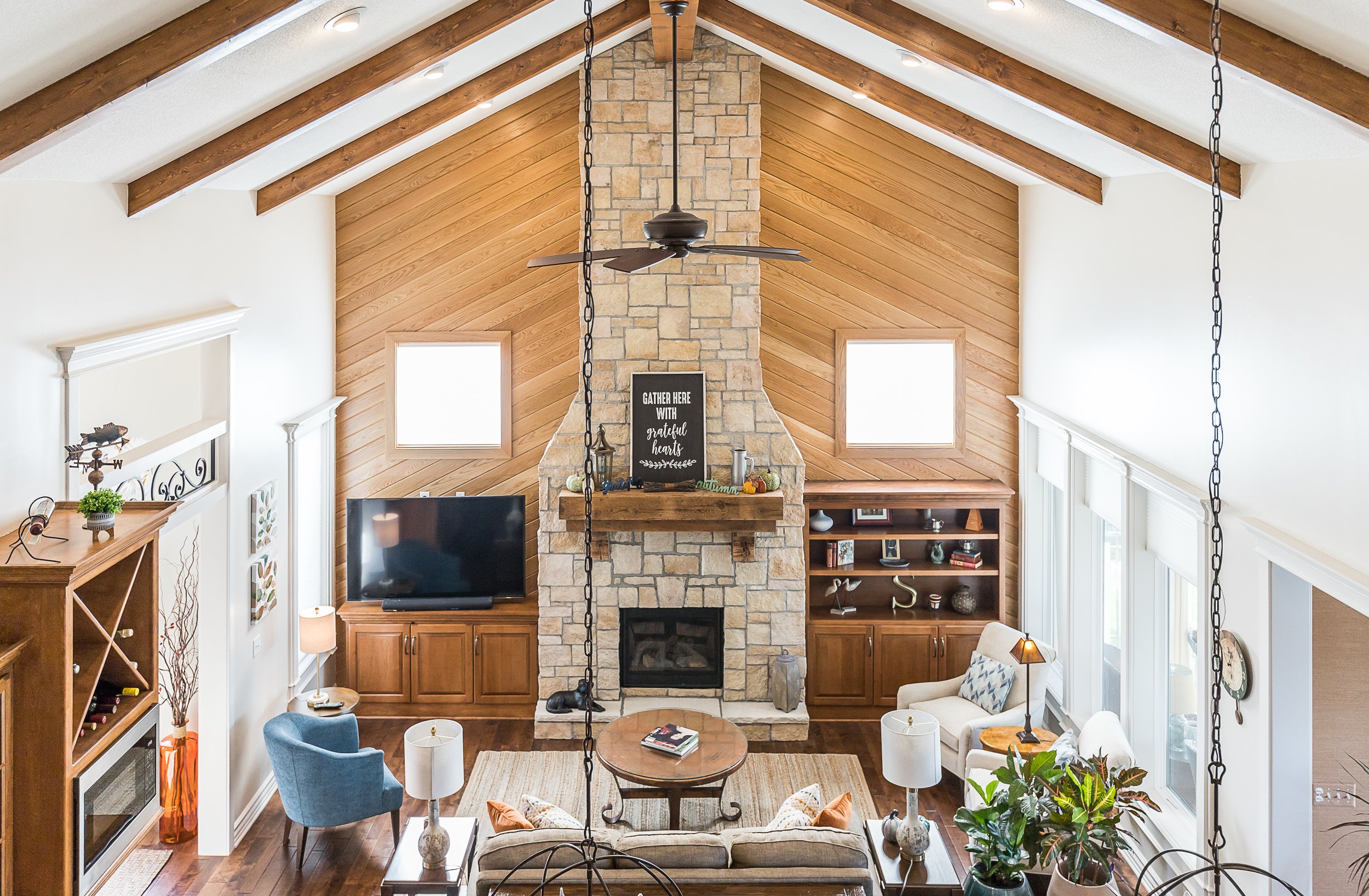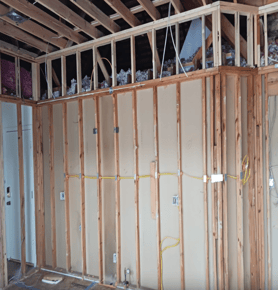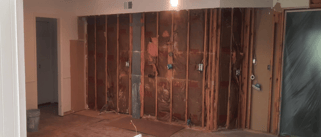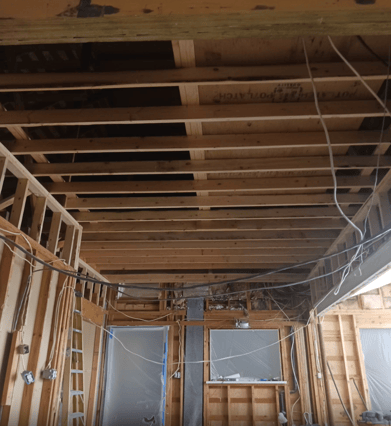Lath & Plaster vs Drywall: Pros and Cons
January 24th, 2024 | 5 min read

When remodeling your home, contractors are at the mercy of the material of what’s inside, particularly regarding how your walls were built and finished. The walls in your home are most likely built using one of two methodologies. Lath & plaster is often found in older homes built prior to World War II, while drywall, or gypsum board, is typically found in modern-day structures. Each has its pros and cons, including different steps that need to be taken during a remodel.
With 20+ years of experience remodeling homes of all ages, RWS has grown accustomed to working with both lath & plaster and drywall. Each has its potential pitfalls, and each requires different steps to achieve the level of finish most homeowners are looking for.
Our goal is to provide you with a lath and plaster vs drywall guide shedding light on the similarities and differences between the two materials, as well as the pros and cons when working with them. We will discuss the importance of knowing which material you have in your home and how this may alter the steps that need to be taken when remodeling your residence.
Lath & Plaster:
Lath and plaster is an older construction technique widely used before the invention of drywall. This technique involves nailing narrow strips of wood (lath) to the framing of a building, and then applying multiple coats of a mixture of plaster and water. Here are some pros and cons that may help you better understand the use of lath & plaster.
Pros
- Aesthetics: Framing lumber manufactured during this time varied greatly in both width and thickness. The multiple layers of liquid plaster were necessary to cover these variations and create straight walls.
- Durability: When properly installed, it can withstand the movement and settling of a structure more so than drywall.
- Environmental Benefits: This installation method uses natural materials (such as lime and sand), increases longevity when properly installed and maintained, minimizes waste, reduces carbon emissions, and its natural composition is easily recyclable.
- Fire Resistance: Depending on the type of plaster used, it can be more fire-resistant than drywall due to its inherent fire-resistant properties.
- Historical Authenticity: In older, historical homes, lath and plaster construction adds authenticity and character, preserving the original aesthetic of the home.
- Insulation: Older lath and plaster walls can contain horsehair, straw, or other natural materials which provide more insulation than drywall due to their thickness and natural qualities.
- Soundproof: This installation method provides better soundproofing compared to modern drywall due to its thicker and denser composition.
Cons
- Costly & Labor Intensive: Due to the specialized labor required, it is costly to repair or install. Both require a qualified specialist, who can be difficult to find.
- Difficulty Repairing: Because of the materials used and the installation process, repairs can be difficult. Older lath and plaster tends to crumble when cut and can expand the size of the area needing to be repaired.
- Messy: Since this process involves mixing and applying wet plaster, it can be challenging to contain.
- Not Suitable for All Environments: In high moisture areas, this process is not ideal and can cause mold (on plaster) and rot (on lath).
- Difficult Hanging Mirrors, Pictures, etc.: Because plaster tends to crumble when a nail or screw is driven into it, hanging objects on the walls becomes more difficult.
- Difficulty In Making Plumbing, HVAC, and Electrical Repairs: Repairs or modifications of plumbing, electrical, and HVAC are much more difficult and skill-intensive when working with lath and plaster.
Drywall:
Because of the improved size consistency in the milling of uniform lumber, drywall has largely replaced lath & plaster in construction due to its speed of installation, cost-effectiveness, and ease of repair. Drywall, or plasterboard or gypsum board, is a common construction material used for interior walls and building ceilings. It’s made from a panel of compressed gypsum, sandwiched between two sheets of heavy paper. For reference, gypsum is a naturally occurring mineral widely available and easily mined. Below you will find some pros and cons that will shed light on why drywall is commonly used in construction today.
Pros
- Cost-Efficiency & Easy Installation: Materials are readily available and usually come in large, easy-to-use panels. Fewer labor hours are required when compared with lath and plaster.
- Fire Resistant Options: There are fire-resistant drywall products available that can provide added levels of safety for fire prevention.
- Quick Drying Properties: Unlike plaster, which requires significant drying times between coats, drywall compound dries relatively quickly, allowing for faster construction timelines.
- Smooth Surface: Drywall provides a smooth and uniform surface that is easy to paint or apply other finishes to.
- Soundproof: Certain types of drywall, when combined with insulation, can offer improved soundproofing qualities.
Cons
- Difficult for Homeowners to Repair: While small holes and dents can be repaired relatively easily, larger repairs or matching textures can be challenging for the average person.
- Prone to Damage: Drywall is more susceptible than other materials to damage from impacts, water, and moisture.
- Extra Steps During The Retrofit of an Older Home: Because modern drywall thickness is uniform and the underlying framing lumber in these older homes is so varied, extra steps must be taken to avoid wavy walls when lath and plaster is replaced with drywall.
- Environmental Impact: The mining process of gypsum can have a negative environmental impact.
Which Material is in Your Home?
 If your home was built before the 1950s and has not had any significant aesthetic upgrades, you likely have lath & plaster inside your home. Determining whether your walls are lath & plaster or drywall is important for proper maintenance, repairs, renovations, and overall understanding of your home’s construction. This knowledge will allow you to make informed decisions about how to properly care for, modify, or improve your living space. The easiest way to tell is with a thumbtack. Choose an inconspicuous spot and try to stick it in the wall. If the tack easily pierces the wall, you have drywall. Another easy way to determine if you have plaster walls is by looking at the walls in an unfinished attic or basement. If you see wood slats covering the walls, you most likely have plaster walls.
If your home was built before the 1950s and has not had any significant aesthetic upgrades, you likely have lath & plaster inside your home. Determining whether your walls are lath & plaster or drywall is important for proper maintenance, repairs, renovations, and overall understanding of your home’s construction. This knowledge will allow you to make informed decisions about how to properly care for, modify, or improve your living space. The easiest way to tell is with a thumbtack. Choose an inconspicuous spot and try to stick it in the wall. If the tack easily pierces the wall, you have drywall. Another easy way to determine if you have plaster walls is by looking at the walls in an unfinished attic or basement. If you see wood slats covering the walls, you most likely have plaster walls.
In either case, knowing if you have lath & plaster or drywall will help you determine the right licensed professionals for your remodel. Asking questions upfront regarding a remodeler’s experience level with lath and plaster is critical and can save you major headaches down the road.
Does My Lathe & Plaster Need To Be Replaced
The larger your remodel project is, the greater the likelihood that you will need to replace the lath and plaster in that area. While a small powder bath remodel or a kitchen refresh may allow you to leave the lathe and plaster in place, projects such as a full kitchen remodel with new cabinetry generally involve modifications of plumbing, electrical, or HVAC within the walls. These in-wall modifications typically trigger the removal and replacement of the existing lathe and plaster with drywall.
My Lath & Plaster Needs To Be Replaced. How Will It Impact My Remodel?
 Removal and replacement of lath & plaster will affect your remodel projects in several ways, from demo through finish. Below is a list of what you should expect.
Removal and replacement of lath & plaster will affect your remodel projects in several ways, from demo through finish. Below is a list of what you should expect.
Demo: Removal of lath and plaster is a messy, labor-intensive affair and often involves days of additional work. Dust shielding and containment need to be well planned out and extra steps need to be taken to protect the pathways through which debris will be taken out of the house.
Mechanical: Once the lath and plaster has been removed it’s common to find a few surprises. Don’t be shocked if you discover a lead pipe drain line or knob and tube wiring that needs to be replaced. Hiring a contractor with experience working in older homes can be the difference between a stalled project and quick mid-project adjustments.
Framing: Because the structural framing in these older homes is rarely straight, new drywall should not be installed directly over the old framing. Attempting to do so can lead to visibly wavy walls, problems mounting cabinetry, and undesirable trim aesthetics. Wood furring strips of varying sizes will need to be measured, cut, and attached to the existing wall studs and ceiling joists to create a straight wall and ceiling surface to attach new drywall.
Finish: Because lath and plaster is thicker than drywall, your window and jambs will stick out beyond the new drywall. An experienced contractor can easily help you identify creative, aesthetically pleasing solutions.
No matter which material and technique the walls in your home were originally finished with, rest assured that a beautiful finish can be achieved. Knowing the differences between these materials and the steps involved in repairing or replacing your lath and plaster will allow you to ask the right questions.
For more residential remodel tips and informative articles, please visit our learning center. If you find yourself ready to move forward with your home renovation project, please complete our RWS contact form here. Expect to receive an email response within 24 hours from Ray Stillions, owner, or Placher Sieben, senior remodeling contractor. We look forward to hearing from you about your potential remodeling needs!
Placher Sieben is a licensed remodeling contractor with RWS Enterprises working with clients, designers, and architects throughout the Kansas City and surrounding areas.
Placher Sieben is a licensed remodeling contractor with RWS Enterprises working with clients, designers, and architects throughout the Kansas City and surrounding areas.
Topics:

